A Hollywood Drama
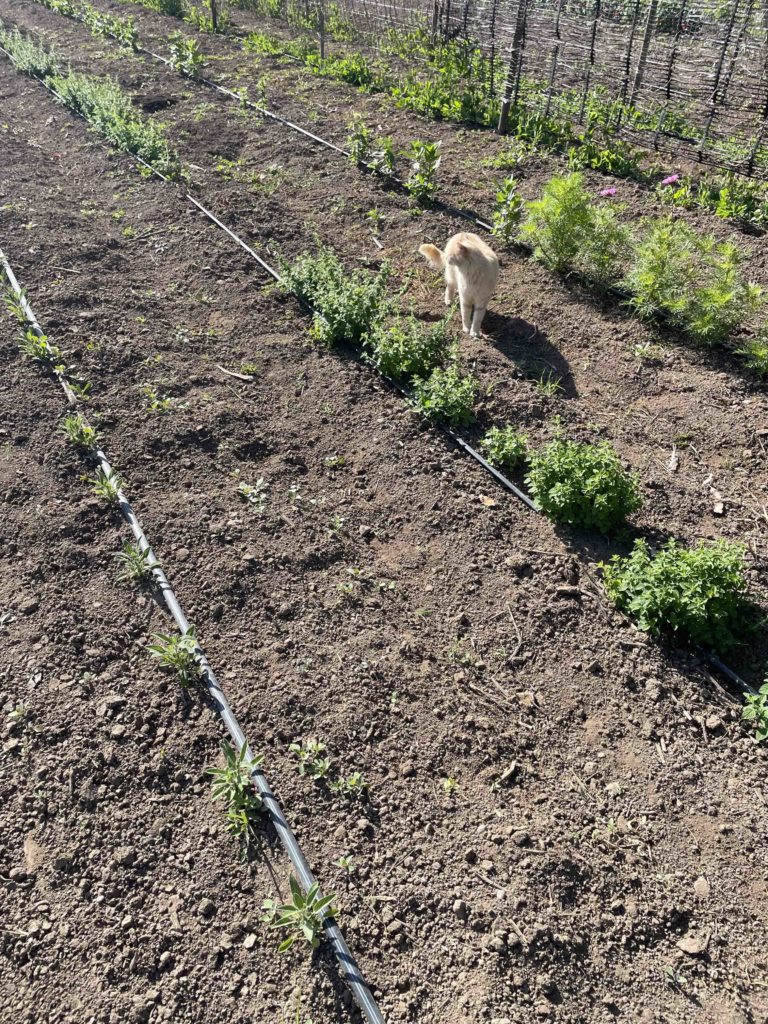
Young sage on left, nepitella (or Roman mint) by Samson, the “royal” cat.
If a prominent plant family were ever to be cast for one of Hollywood’s full-on “franchise treatments,” with a series, some movies, then spin-offs, with prequels and sequels and endless branding and merchandising opportunities, then certainly the Mints deserve consideration; consider the family’s sweeping cast of characters with their aromatic flair and drama:
The mint family is now properly known as the “Lamiacea,” and there are over 230 different genera within it. The family was once called the “Labiatea” until the taxonomists changed everything around to make botany fun and challenging. Think of the present day English royal family, which used to be the “House of Saxe Coburg and Gotha” until the First World War made a German surname unpalatable to the English Monarch, so he changed the family name to “House of Windsor,” renaming his dynasty after their principle castle of Windsor. The mint family- or Lamiacea– even have royalty in their blood. “Basil” even means “regal,” and basil is in the mint family, and they are worth a miniseries all on their own.
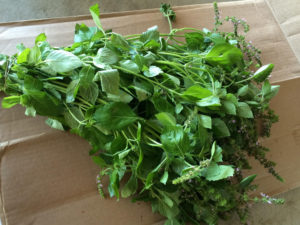
Tulsi basil
Basils are richly scented with evocative, spicy perfumes. They are reputed to be good in the kitchen and in bed. One of them, Tulsi, is even a Goddess. There are many branches in the mint family, but a common thread that almost all the distant cousins share is that they are fragrant. When I was reading up on the mint family I was surprised to even find that the teak trees are mints! I wonder what their foliage smells like? Then I remembered that when I helped a friend with his basil farm down in Todos Santos, we had a Genovese basil plant at the edge of the field that escaped getting turned under by the disk at the end of the season. When next spring came that plant had grown a trunk as thick as my arm and was as tall as I was. And I read that wood of Tulsi basil is carved into prayer beads.
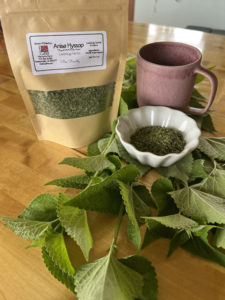
Anise Hyssop, another member of the mint family.
Then there are the so-called “mints,” themselves, those aromatic herbs that have lent their common name to the family Lamiaceae. There’s Peppermint to clean up your breath, while Pennyroyal mint is known for being a folk abortifacient. Spearmint takes you to the horse races for a proper mint julep and Applemint tea soothes your jagged nerves. Mints come from all over the world and influence all the cuisines that they touch. The Mints could carry a travel-the-world cooking show all by themselves. From Vietnam to North Africa to England mint just keeps popping up on menus in fancy drinks and herbal tisanes, in stews and salads, and in rubs, jellies, and marinades.
Lavenders are mints too. Like their cousins, they’re fragrant. And, as with other mints, their stems are square. Lavender plays a “walk-on role” on the dessert menu, and it shows up in fancy cocktails and in candies, but it’s a full-on megastar in the perfume business. And it’s one of those rare plants whose name is synonymous with a color and an attitude; remember the Lavender Panthers?
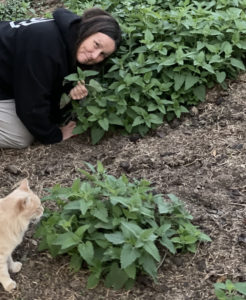
Starr mingling with royalty, Samson, by the catnip.
People aren’t the only creatures that appreciate mint. There are mints for cats, like catnip, catmint, and cat thyme. And there are mints to attract bees, like Bee Balm, and mints to repel fleas, like Rosemary. Sages are mints, and many of them are extremely attractive to birds. Pineapple sage leaves makes a nice calming, herbal tisane for a human but the Hummingbirds come to the plants to tank up on sugary nectar from the plant’s long red flowers and they get a sweet rush that gets their tiny hearts pumping up to 1,260 beats per minute. Culinary sage is revered as an herb for roasting game birds, but it’s also synonymous with wisdom, and a “sage” is a wise man.
There’s also a sage called Salvia divinorum, the “Diviner’s sage,” that can bring on hallucinations and other altered states of consciousness. The New Riders Of The Purple Sage were a drugged up country rock band back in the 70s in the Bay Area, whose songbook emphasized mescalito and marijuana but, oddly, not the psychedelic Diviners’ sage. Their band name alluded to the dime store western novel “Riders of Purple Sage,” by Zane Gray. Ironically, the Great Basin desert’s sagebrush that Zane Grey romantically infused with his purple prose is not a true sage, or even a mint family member, but actually belongs to the Artemisia clan. But what family drama would be complete without some interloper trying to seize the family’s inheritance?
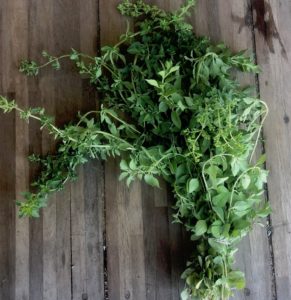
Fresh oregano
Oreganos and marjorams are mints that typically enjoy sunnier, drier, and more well-drained conditions. We speak of “Italian oregano,” “Greek oregano,” and “Sweet Marjoram,” and “Za’atar,” or “Syrian marjoram,” but, as so often in life, once we leave the precise, library-like confines of taxonomy behind and go out into the field, we encounter a more confusing family dynamic. The oreganos and marjorams grow wild, as well as in the garden, and they interbreed willingly. They’ve been carried by gardeners and traded around the world to the point where precise origins and genetic makeup of any particular plant are blurred with time. It’s probably more correct to think of the different types of oregano/marjoram as being “points along a spectrum,” or salient characters from a hybrid swarm. There’s drama there, but if herb makes your red sauce piquant, it’s all good.
Thyme to end…Thymes are mints too. We’ve got “regular” thyme in our gardens, and Lemon thyme, Silver thyme, creeping thyme, and Lime thyme. In fact, many of the mint family members grow well here, and Starr has been drying many of them for use in the kitchen, bath, flower or in the teacup.
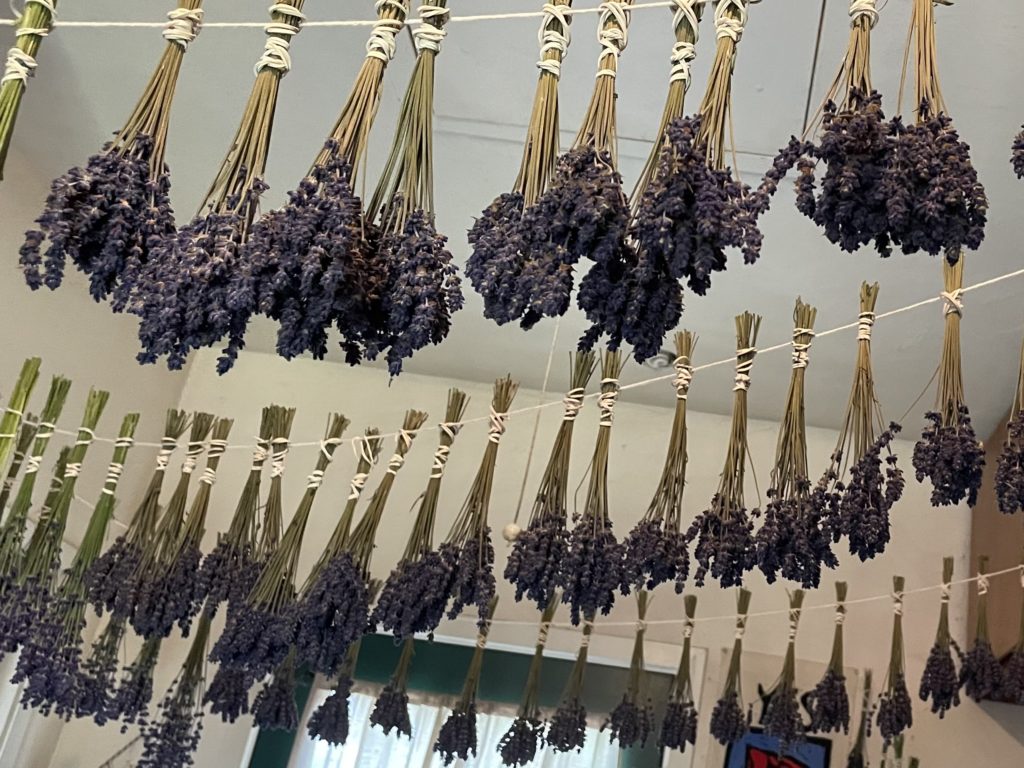
Bundles of Lavender in the drying room.
Throughout the season we can offer:
English and French Lavender wands, loose Lavender florets, and Lavender bath salts
Anise Hyssop
Culinary Oregano
Sweet Marjoram
Za’atar, or Syrian Marjoram
Delightful Rosemary
and Plenty of Thyme
Plus we’ve got garden Sage planted and on its way, and of course we have Lemon Balm and Lemon Thyme to keep our Lemon trees company. And we even have Lemon Verbena, which isn’t (at this moment) technically a mint, but there are taxonomists who would like to put it in the Lamiaceae. If anybody can make taxonomy sexy, spicy, comforting, or hallucinatory, it would be the mint family.
Everyone take your places…Ready…Camera…Action!
Andy & the crew at Mariquita Farm.
© 2022 Essay by Andy Griffin
Photos by Andy Griffin & Starling Linden


